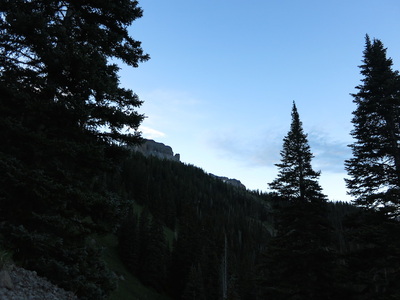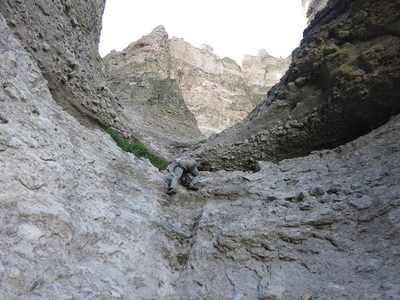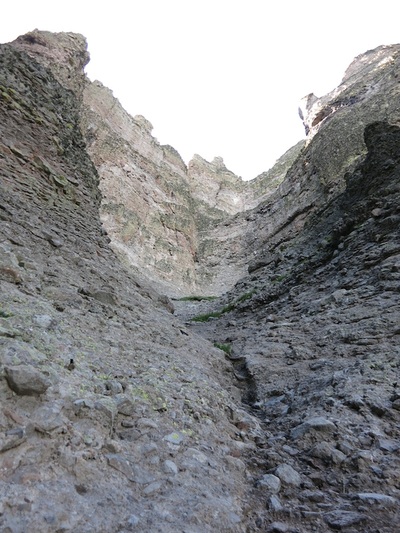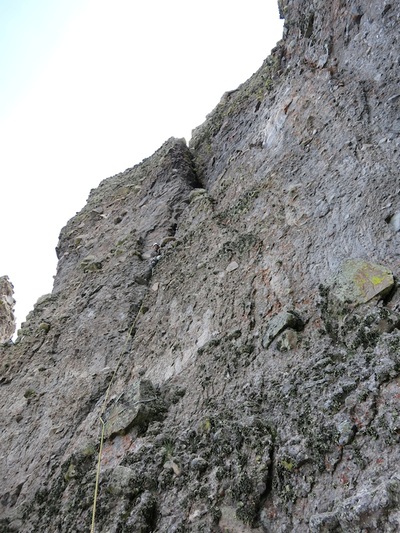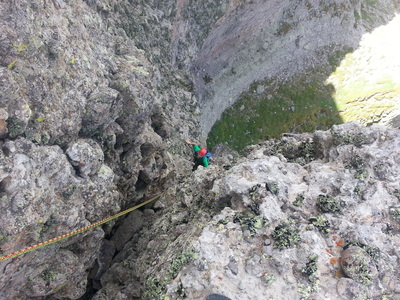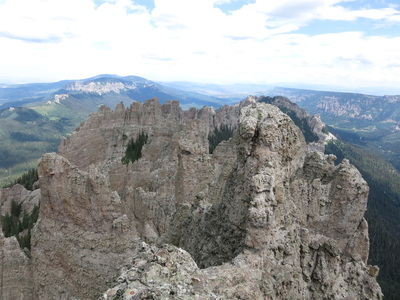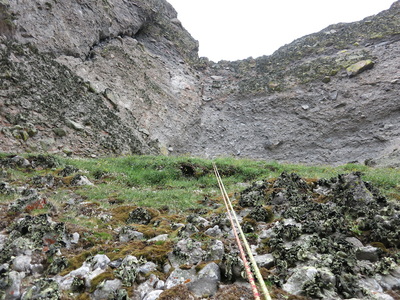Turret Ridge via West Gully (5.9S)
July 24, 2014
Partner: Dave Goldstein
"Nothing but the best!" - DG
Partner: Dave Goldstein
"Nothing but the best!" - DG
Very few peaks carry with them a reputation as large as "Colorado's hardest 12er", Turret Ridge. Information on this notorious peak is scarce at best, and the few recorded climbs describe rotten rock, crumbling walls and a general lack of safe climbing. Turret Ridge was a highly coveted climb and the "first" ascent was completed in 1991 by Colorado peak-bagging legend Mike Garratt, George Fuller and Terry Root. The party worked it's way up the sheer walls onto the exposed summit and were shocked to find a small register containing the names of 3 members of the Iowa Mountaineers who had been the actual first ascent party in 1979.* Obviously this type of objective does not attract many climbers, and to this day Turret Ridge sees only a handful of ascents from Colorado's most involved peak-baggers, especially those intent on scaling all of the 12ers.
My relationship with Turret Ridge began several years ago when some of my climbing partners brought it to my attention as something we should check out. I have to admit that my weakness is seldom-climbed peaks, but my general lack of climbing ability kept 5.9 garbage rock out of my sights and eventually out of my mind. That was until last year, when I began communicating with longtime desert hard man and adventure climbing connoisseur, Dave. Not only was Dave gung-ho to climb Turret Ridge, but when I expressed a concern about safety with my first child on the way, he happily volunteered to lead everything. Obviously my wife was very happy to hear this and the plan was set. After battling dates and weather, we finally settled on a time, and before I knew it I was making the eternal and lonely drive down to the Cimarron Range.
I have to admit that the drive seemed longer than usual, especially since I had been down in the area just the week before. A sense of relief came as I turned up onto the nice dirt road up toward Owl Creek Pass, and I motored upward without seeing any other traffic. As I drove around Silver Jack Reservoir, the abrupt view of Turret Ridge's jagged flanks caused me to come to a sliding stop. The view was so striking that I stood outside the car and took it all in before wanting to complete the drive. Eventually I moved on and soon met Dave up on the pass and followed him down the road to a nice camping spot immediately between the impressive Chimney Rock and Turret Ridge's summit tower. We spent the night chatting about the upcoming climb, sorting gear and getting devoured by bloodthirsty mosquitoes.
The morning came slowly after a night spent tossing and turning in the back of my car, and before I knew it we were grinding up the steep slopes. Thankfully the deadfall was much better than I had expected, but I couldn't help thinking about how many times I was going to fall down coming back down the steeply vegetated hillside. We gained some company after Dave's dog Wilbur had escaped his officially titled "backpacking dog nanny" and sprinted up the slopes to join us. Our arrival at the Dusinane/Turret Ridge saddle was joyous as we hit the best animal trail I have ever experienced. The literal highway was better than many constructed trails I had been on and it carried us straight to the dramatic cliffs of Turret Ridge. As we contoured around to reach the start of the climb, I craned my neck upward to marvel at the cobbled face above and couldn't help wondering what was holding it all together. "Nothing but the best!" Dave chimed in and we soon sat at the base of the route.
The steep gully reminded my sharply of my experience on Ship Rock. We donned harnesses, gear, and shoes, and Dave carefully tied Wilbur up in a safe alcove to shelter him from the inevitable rock fall we would send cascading downward. Initially the climbing went smoothly and we cautiously scrambled upward, carefully testing every hold protruding from the gully. Overall the rock seemed better than we had expected, but different layers had differing attitude about how much they would let you pull on them. The easy scramble gave way to steeper slopes, and we belayed a pitch up to the base of the obvious chimney that marked the beginning of the real climbing. Dave started up the chimney and had to battle a healthy crop of brushy growth in the lower section of the pitch. The climbing soon reared up and it became obvious that trusting the rock was the name of the game. A large chockstone blocked access, and Dave stemmed cautiously around it and disappeared out of sight. I slowly payed out the rope as I watched some questionable clouds blowing immediately overhead and couldn't help but wonder what the sky looked everywhere else. Before long I heard the familiar "off belay" come echoing down and I quickly started climbing. Immediately I was impressed with Dave's lead as the climbing was dirty and harder than expected. Cleaning gear in the back of the dark chimney was taxing with a pack on, and I'm sure Dave wondered what was happening with my continual grumbling. Eventually I reached the belay and moved higher up onto a ledge to be closer to the base of the next pitch which was supposedly the crux of the climb.
Once again, Dave set off across the inertial traversing and unprotected face to reach the crack above. The weather seemed stable, but large clouds periodically blew just into sight over the summit before disappearing again. I heard a laugh from above and glanced up to see Dave laughingly holding up a large rock and exclaiming, "My handhold!" I smiled and informed him to "Be careful, you're having too much fun!" The crux came as a short overhanging section blocking access to the upper crack, and I couldn't help but be worried as it appeared much steeper with a climber than it looked before. After a momentary nesting of gear, Dave made quick work of the moves and cruised up to the belay before I knew it. The climbing initially went smoothly and I paused nervously under the large overhang. I was starting to get used to the rock, but making powerful moves on these cobbles still was sitting on my mind. Thankfully, Dave gave me a tight belay and I soon joined him up on a wonderfully exposed ledge just below the summit. These were the first views we had of the surrounding terrain, and the broken mass of Turret Ridge's northern slopes was incredible. My attention was pulled back as I noticed that not only was the next pitch much more of a traverse than I had expected, but it was also covered in the thickest lichen crop I have ever seen in person. A slight knot crept into my stomach as Dave carefully launched across the steep wall and I watched the occasional rock fall into the void below him. It was surprising that not only was there zero elevation gain on the pitch, but he was a few feet lower than me as he disappeared around the corner and exclaimed "off belay". As the rope came in, I focused on my breathing and stepped down onto the first cobble. I was very thankful that Dave had protected the traverse every few feet, but I knew that many of the placements were just about as good as they looked. Halfway across, as I was knocking some loose holds off with my foot, my seemingly solid hand snapped sharply out of the wall and hit me in the face as I shifted my weight to not fall into the open air. A few choice words came freely out as I held on and then continued smoothly the rest of the way to the belay. The summit was finally in sight and it was glorious knowing we were practically there.
We quickly shifted everything around, and as Dave moved up I noticed a few drops of rain beginning to fall. My eyes scanned the sky and I couldn't help but imagining the thick lichen becoming a slippery death trap. Fortunately, it stopped as quickly as it began and Dave called off belay from the summit. As I continued up the final lichen-encrusted moves toward the top, my motivation was increased by a sudden peal of thunder. I scampered as quickly as I could to join Dave at the sudden summit, and was happy to see the sky looked decent and the storm appeared to be off over the Courthouse for the time being. The summit was wonderfully exposed, and the dramatic views were among the best I have seen. The summit register looked good from the outside, but I poured water out of it and didn't even attempt to extract the soggy mess from the inside. Snapping a few photos was all the time we took, and a few more rolls of thunder moved us along. Dave belayed me down to a large pillar covered in old rappel slings, and I brought him over to inspect the anchor. We both decided it appeared reasonably trustworthy for an ancient anchor. Dave cruised out of sight and I tried not to focus on the thunder that kept occasionally breaking the silence. I soon followed and carefully maneuvered as to not send missiles down immediately onto my partner below. The next rappels went smoothly and the weather seemed to relax the lower we got. Rockfall was an issue, but thankfully we didn't have any major problems. After the final rappel, we pulled the ropes and scrambled down to where Wilbur had patiently waited. We chatted about the Fisher towers and the climb and the hike out was enjoyable, although a light rain made for some slick terrain. It had been a memorable climb and I couldn't be more thankful for such a great partner.
My relationship with Turret Ridge began several years ago when some of my climbing partners brought it to my attention as something we should check out. I have to admit that my weakness is seldom-climbed peaks, but my general lack of climbing ability kept 5.9 garbage rock out of my sights and eventually out of my mind. That was until last year, when I began communicating with longtime desert hard man and adventure climbing connoisseur, Dave. Not only was Dave gung-ho to climb Turret Ridge, but when I expressed a concern about safety with my first child on the way, he happily volunteered to lead everything. Obviously my wife was very happy to hear this and the plan was set. After battling dates and weather, we finally settled on a time, and before I knew it I was making the eternal and lonely drive down to the Cimarron Range.
I have to admit that the drive seemed longer than usual, especially since I had been down in the area just the week before. A sense of relief came as I turned up onto the nice dirt road up toward Owl Creek Pass, and I motored upward without seeing any other traffic. As I drove around Silver Jack Reservoir, the abrupt view of Turret Ridge's jagged flanks caused me to come to a sliding stop. The view was so striking that I stood outside the car and took it all in before wanting to complete the drive. Eventually I moved on and soon met Dave up on the pass and followed him down the road to a nice camping spot immediately between the impressive Chimney Rock and Turret Ridge's summit tower. We spent the night chatting about the upcoming climb, sorting gear and getting devoured by bloodthirsty mosquitoes.
The morning came slowly after a night spent tossing and turning in the back of my car, and before I knew it we were grinding up the steep slopes. Thankfully the deadfall was much better than I had expected, but I couldn't help thinking about how many times I was going to fall down coming back down the steeply vegetated hillside. We gained some company after Dave's dog Wilbur had escaped his officially titled "backpacking dog nanny" and sprinted up the slopes to join us. Our arrival at the Dusinane/Turret Ridge saddle was joyous as we hit the best animal trail I have ever experienced. The literal highway was better than many constructed trails I had been on and it carried us straight to the dramatic cliffs of Turret Ridge. As we contoured around to reach the start of the climb, I craned my neck upward to marvel at the cobbled face above and couldn't help wondering what was holding it all together. "Nothing but the best!" Dave chimed in and we soon sat at the base of the route.
The steep gully reminded my sharply of my experience on Ship Rock. We donned harnesses, gear, and shoes, and Dave carefully tied Wilbur up in a safe alcove to shelter him from the inevitable rock fall we would send cascading downward. Initially the climbing went smoothly and we cautiously scrambled upward, carefully testing every hold protruding from the gully. Overall the rock seemed better than we had expected, but different layers had differing attitude about how much they would let you pull on them. The easy scramble gave way to steeper slopes, and we belayed a pitch up to the base of the obvious chimney that marked the beginning of the real climbing. Dave started up the chimney and had to battle a healthy crop of brushy growth in the lower section of the pitch. The climbing soon reared up and it became obvious that trusting the rock was the name of the game. A large chockstone blocked access, and Dave stemmed cautiously around it and disappeared out of sight. I slowly payed out the rope as I watched some questionable clouds blowing immediately overhead and couldn't help but wonder what the sky looked everywhere else. Before long I heard the familiar "off belay" come echoing down and I quickly started climbing. Immediately I was impressed with Dave's lead as the climbing was dirty and harder than expected. Cleaning gear in the back of the dark chimney was taxing with a pack on, and I'm sure Dave wondered what was happening with my continual grumbling. Eventually I reached the belay and moved higher up onto a ledge to be closer to the base of the next pitch which was supposedly the crux of the climb.
Once again, Dave set off across the inertial traversing and unprotected face to reach the crack above. The weather seemed stable, but large clouds periodically blew just into sight over the summit before disappearing again. I heard a laugh from above and glanced up to see Dave laughingly holding up a large rock and exclaiming, "My handhold!" I smiled and informed him to "Be careful, you're having too much fun!" The crux came as a short overhanging section blocking access to the upper crack, and I couldn't help but be worried as it appeared much steeper with a climber than it looked before. After a momentary nesting of gear, Dave made quick work of the moves and cruised up to the belay before I knew it. The climbing initially went smoothly and I paused nervously under the large overhang. I was starting to get used to the rock, but making powerful moves on these cobbles still was sitting on my mind. Thankfully, Dave gave me a tight belay and I soon joined him up on a wonderfully exposed ledge just below the summit. These were the first views we had of the surrounding terrain, and the broken mass of Turret Ridge's northern slopes was incredible. My attention was pulled back as I noticed that not only was the next pitch much more of a traverse than I had expected, but it was also covered in the thickest lichen crop I have ever seen in person. A slight knot crept into my stomach as Dave carefully launched across the steep wall and I watched the occasional rock fall into the void below him. It was surprising that not only was there zero elevation gain on the pitch, but he was a few feet lower than me as he disappeared around the corner and exclaimed "off belay". As the rope came in, I focused on my breathing and stepped down onto the first cobble. I was very thankful that Dave had protected the traverse every few feet, but I knew that many of the placements were just about as good as they looked. Halfway across, as I was knocking some loose holds off with my foot, my seemingly solid hand snapped sharply out of the wall and hit me in the face as I shifted my weight to not fall into the open air. A few choice words came freely out as I held on and then continued smoothly the rest of the way to the belay. The summit was finally in sight and it was glorious knowing we were practically there.
We quickly shifted everything around, and as Dave moved up I noticed a few drops of rain beginning to fall. My eyes scanned the sky and I couldn't help but imagining the thick lichen becoming a slippery death trap. Fortunately, it stopped as quickly as it began and Dave called off belay from the summit. As I continued up the final lichen-encrusted moves toward the top, my motivation was increased by a sudden peal of thunder. I scampered as quickly as I could to join Dave at the sudden summit, and was happy to see the sky looked decent and the storm appeared to be off over the Courthouse for the time being. The summit was wonderfully exposed, and the dramatic views were among the best I have seen. The summit register looked good from the outside, but I poured water out of it and didn't even attempt to extract the soggy mess from the inside. Snapping a few photos was all the time we took, and a few more rolls of thunder moved us along. Dave belayed me down to a large pillar covered in old rappel slings, and I brought him over to inspect the anchor. We both decided it appeared reasonably trustworthy for an ancient anchor. Dave cruised out of sight and I tried not to focus on the thunder that kept occasionally breaking the silence. I soon followed and carefully maneuvered as to not send missiles down immediately onto my partner below. The next rappels went smoothly and the weather seemed to relax the lower we got. Rockfall was an issue, but thankfully we didn't have any major problems. After the final rappel, we pulled the ropes and scrambled down to where Wilbur had patiently waited. We chatted about the Fisher towers and the climb and the hike out was enjoyable, although a light rain made for some slick terrain. It had been a memorable climb and I couldn't be more thankful for such a great partner.
*Bueler, William M.. Roof of the Rockies: a history of Colorado mountaineering. 3rd ed. Golden, Colo.: Colorado Mountain Club Press, 2000. Print.
Route Description...
Thoughts from both Dave and me:
Turret Ridge, with over 300' of sustained technical climbing on dubious rock, is probably the most demanding Colorado mountain to summit. Other contenders for the honor of hardest Colorado mountain summit include Lizard Head and Twin Peaks (C) in the La Garitas either of which is at least a step below Turret Ridge. (This opinion is based on having lead all pitches of all of these climbs.) Lizard Head has less climbing and much less loose rock. Twin Peaks has perhaps 1/3 as much climbing as Turret; the lower two thirds of Twin Peaks has worse rock but the protection is better and the style of climbing less affected by the bad rock. Neither Lizard Head nor Twin Peaks has a "bad for everyone" passage like Turret's fourth pitch traverse.
That said, Turret was not the horror show we had been lead to expect and is actually a recommended climb for those with experience climbing on bad rock. Every pitch is engaging and the most worrisome sections are short. The traverse pitch, if you can collect your wits long enough to appreciate it, is quite memorable at the grade. While the rock quality exceeded expectations, the loose, lichen-covered cobbles continually required patience and an array of skills to surpass. Much of the climbing would not require much thought if in the gym or Boulder Canyon or after another thousand ascents, but the continual cleaning of lichen and testing/avoiding of holds is draining. (Both members of our party had holds fail on them.)
The summit has a very pristine feeling and it was an honor to have stood in a place that very few have.
Strategy:
Get an early start. Every phase of the climb took longer than we expected. The peak has a decent amount of prominence and is a bad place to be in a storm: not only would it be a lightning rod but a strong rain would likely unloose a shower of stone down the descent line. A single party of two is recommended. This would be a terrible route to be behind another party on. If you're wondering whether you're up to this climb, do Chimney Peak, a mile west across the valley, as a dress rehearsal. The climbing is easier on Chimney and the rock better but both are similar in nature. If you don't feel totally solid leading Chimney, you're probably not ready for Turret.
Cruxes: This is a climb where the hardest climbing is not the "business". The technical crux is midway up pitch 2, but the most serious climbing is at the beginning of pitch one where the first 15' is obscured by plants and very difficult to protect, the beginning of pitch two where the final moves of the traverse into the crack entail marginally protected climbing on poor rock and the entirety of pitch four where all holds and protection are suspect and a gear ripping fall by leader or follower could have dire consequences. Aside from these sections, the climb is pretty well protected.
Archival notes:
Turret's conglomerate rock is reminiscent of the towers of Riglos in northern Spain where it is called puddingstone.The lichen on this route dates to the Garden of Eden.
Approach:
From near the summit of Owl Creek Pass, head south a short distance on 860A and find a good place to park below Turret Ridge's impressive summit block. 38.141127, -107.557518
Either wade the river or find a log to cross and carefully work through the initial marshy section without getting your feet wet. Navigate toward the Dusinane/Turret Ridge saddle trying to avoid a few sections of steep grass and downed trees. From the saddle, easily follow the glorious animal highway straight toward Turret Ridge. Duck under the initial buttress to the west losing as little elevation as possible while passing under the impressive cliffs above. Pass the first gully system as it is not the correct one and is easily identified by an obvious vertical band a short distance up it. The second gully is where the route begins and there is a nice alcove on the south (right) side of the entrance to sort gear and get ready for the business above.
Route:
P0 - 5.0 - Scramble up the obvious gully following the path of most solid rock. Class 2 becomes class 4 and a short 5.0 wall deposits you on a small ledge with a slung block rappel anchor. 250'
P1 - 5.0-5.2 - From the slung block, continue upward on varied terrain trying not to knock the loose rubble down onto your partner. The gully ends at a dark chimney and a 2 bolt belay is on grassy stance on climber's right. 160'
P2 - 5.7 - Traverse left to the base of the chimney and work upward on the unnerving holds. Stem around a large chockstone and continue up the groove until it is possible to escape right to a bolted belay stance below a large ledge. 120'
P2.5 - 5.0 - "Fifth-Class-Grass". Move the belay up to the ledge above and belay from a slung boulder at the base of the next pitch. 50'
P3 - 5.8/5.9 (hard to accurately rate since much effort is put into testing and avoiding holds) - Make an ascending traverse to the left to reach the lower portion of the obvious crack above. Dodging the lichen is a small problem on the lower portion of the pitch as the better rock is thick with it, and the clean rock is quite poor in comparison. Follow the crack upward to reach a rest stance below an imposing overhang. Crank the overhang on positive, yet non-comforting cobbles and continue up the steep crack above to a small, exposed belay ledge with a single bolt. 110'
P4 - 5.6S - "The Lichen Traverse". Step down a few feet and make an exposed traverse straight right on protruding cobbles to reach the final gully to the summit and a belay from two historical pitons and supplemental cams. Little elevation is gained on this pitch which is covered in the healthiest crop of lichen imaginable. Gear is thankfully plentiful, but dodgy at best. A fall from the second would be on par with a fall from the leader and this is the most serious pitch on the route. 40'
P5 - 5.0-5.2 - More lichen climbing leads up to the abrupt summit. Gear is scant to nonexistent on the summit but a solid body counterweight anchor is easily arranged. Note the sling draped pillar 30' below the top is the first rappel anchor. Finally, this could be combined with the previous pitch with the upward nature of the line potentially offering some better protection to the second, but rope drag would be excruciating. 120'
**There is yet another useless CMC PVC tube containing a sodden lump of wood pulp pointlessly lashed to the summit by a cable. We brought a Garret style register to the base but forgot the include it in our summit pack.**
Descent: Carefully descend the last pitch until you reach the large, sling-covered pillar.
R1 - Double-rope rappel to reach the slung boulder belay at the base of P3. ~50 meters.
R2 - Double-rope rappel to reach the bolted anchor below the P2 chimney.
R3 - Double-rope rappel down the lower angled gully to the small slung block below P1.
R4 - Last double rope rappel as far toward the base as comfort dictates then scramble to your gear.
**All rappels require 2 ropes!**
**All anchor slings should be inspected carefully as well as what they are attached to.**
**There is substantial risk of the second rappeller knocking down rocks which imperil the first rappeller. The first one down should try to find shelter and the second rappeller should take extra care to dislodge as few rocks as possible.**
Gear:
Come prepared for bear. We brought:
1 each #1-#8 rock.
1 each .5-2.5 Tri Cam.
1 each .4-.75 Camalot.
2 each #1-#4 Camalot (or equivalent).
1 each #4 Friend, #5, #6 C4 Camalot.
About 8 quickdraws, 16 shoulder length runners, 5 double or quadruple length runners with free biners to match .
Thin runners are useful for draping over protuberances.
**All this gear was used (except for the .5 Tri Cam) but if you wanted to cut back, the #6 Camalot and some of the extra long runners could be eliminated. Many of the best placements were Tri Cams and nuts. Fixed rap slings seems to deteriorate quickly on this climb. Parties should come equipped with at least 50' of cord and a knife to bolster anchors.**
Turret Ridge, with over 300' of sustained technical climbing on dubious rock, is probably the most demanding Colorado mountain to summit. Other contenders for the honor of hardest Colorado mountain summit include Lizard Head and Twin Peaks (C) in the La Garitas either of which is at least a step below Turret Ridge. (This opinion is based on having lead all pitches of all of these climbs.) Lizard Head has less climbing and much less loose rock. Twin Peaks has perhaps 1/3 as much climbing as Turret; the lower two thirds of Twin Peaks has worse rock but the protection is better and the style of climbing less affected by the bad rock. Neither Lizard Head nor Twin Peaks has a "bad for everyone" passage like Turret's fourth pitch traverse.
That said, Turret was not the horror show we had been lead to expect and is actually a recommended climb for those with experience climbing on bad rock. Every pitch is engaging and the most worrisome sections are short. The traverse pitch, if you can collect your wits long enough to appreciate it, is quite memorable at the grade. While the rock quality exceeded expectations, the loose, lichen-covered cobbles continually required patience and an array of skills to surpass. Much of the climbing would not require much thought if in the gym or Boulder Canyon or after another thousand ascents, but the continual cleaning of lichen and testing/avoiding of holds is draining. (Both members of our party had holds fail on them.)
The summit has a very pristine feeling and it was an honor to have stood in a place that very few have.
Strategy:
Get an early start. Every phase of the climb took longer than we expected. The peak has a decent amount of prominence and is a bad place to be in a storm: not only would it be a lightning rod but a strong rain would likely unloose a shower of stone down the descent line. A single party of two is recommended. This would be a terrible route to be behind another party on. If you're wondering whether you're up to this climb, do Chimney Peak, a mile west across the valley, as a dress rehearsal. The climbing is easier on Chimney and the rock better but both are similar in nature. If you don't feel totally solid leading Chimney, you're probably not ready for Turret.
Cruxes: This is a climb where the hardest climbing is not the "business". The technical crux is midway up pitch 2, but the most serious climbing is at the beginning of pitch one where the first 15' is obscured by plants and very difficult to protect, the beginning of pitch two where the final moves of the traverse into the crack entail marginally protected climbing on poor rock and the entirety of pitch four where all holds and protection are suspect and a gear ripping fall by leader or follower could have dire consequences. Aside from these sections, the climb is pretty well protected.
Archival notes:
Turret's conglomerate rock is reminiscent of the towers of Riglos in northern Spain where it is called puddingstone.The lichen on this route dates to the Garden of Eden.
Approach:
From near the summit of Owl Creek Pass, head south a short distance on 860A and find a good place to park below Turret Ridge's impressive summit block. 38.141127, -107.557518
Either wade the river or find a log to cross and carefully work through the initial marshy section without getting your feet wet. Navigate toward the Dusinane/Turret Ridge saddle trying to avoid a few sections of steep grass and downed trees. From the saddle, easily follow the glorious animal highway straight toward Turret Ridge. Duck under the initial buttress to the west losing as little elevation as possible while passing under the impressive cliffs above. Pass the first gully system as it is not the correct one and is easily identified by an obvious vertical band a short distance up it. The second gully is where the route begins and there is a nice alcove on the south (right) side of the entrance to sort gear and get ready for the business above.
Route:
P0 - 5.0 - Scramble up the obvious gully following the path of most solid rock. Class 2 becomes class 4 and a short 5.0 wall deposits you on a small ledge with a slung block rappel anchor. 250'
P1 - 5.0-5.2 - From the slung block, continue upward on varied terrain trying not to knock the loose rubble down onto your partner. The gully ends at a dark chimney and a 2 bolt belay is on grassy stance on climber's right. 160'
P2 - 5.7 - Traverse left to the base of the chimney and work upward on the unnerving holds. Stem around a large chockstone and continue up the groove until it is possible to escape right to a bolted belay stance below a large ledge. 120'
P2.5 - 5.0 - "Fifth-Class-Grass". Move the belay up to the ledge above and belay from a slung boulder at the base of the next pitch. 50'
P3 - 5.8/5.9 (hard to accurately rate since much effort is put into testing and avoiding holds) - Make an ascending traverse to the left to reach the lower portion of the obvious crack above. Dodging the lichen is a small problem on the lower portion of the pitch as the better rock is thick with it, and the clean rock is quite poor in comparison. Follow the crack upward to reach a rest stance below an imposing overhang. Crank the overhang on positive, yet non-comforting cobbles and continue up the steep crack above to a small, exposed belay ledge with a single bolt. 110'
P4 - 5.6S - "The Lichen Traverse". Step down a few feet and make an exposed traverse straight right on protruding cobbles to reach the final gully to the summit and a belay from two historical pitons and supplemental cams. Little elevation is gained on this pitch which is covered in the healthiest crop of lichen imaginable. Gear is thankfully plentiful, but dodgy at best. A fall from the second would be on par with a fall from the leader and this is the most serious pitch on the route. 40'
P5 - 5.0-5.2 - More lichen climbing leads up to the abrupt summit. Gear is scant to nonexistent on the summit but a solid body counterweight anchor is easily arranged. Note the sling draped pillar 30' below the top is the first rappel anchor. Finally, this could be combined with the previous pitch with the upward nature of the line potentially offering some better protection to the second, but rope drag would be excruciating. 120'
**There is yet another useless CMC PVC tube containing a sodden lump of wood pulp pointlessly lashed to the summit by a cable. We brought a Garret style register to the base but forgot the include it in our summit pack.**
Descent: Carefully descend the last pitch until you reach the large, sling-covered pillar.
R1 - Double-rope rappel to reach the slung boulder belay at the base of P3. ~50 meters.
R2 - Double-rope rappel to reach the bolted anchor below the P2 chimney.
R3 - Double-rope rappel down the lower angled gully to the small slung block below P1.
R4 - Last double rope rappel as far toward the base as comfort dictates then scramble to your gear.
**All rappels require 2 ropes!**
**All anchor slings should be inspected carefully as well as what they are attached to.**
**There is substantial risk of the second rappeller knocking down rocks which imperil the first rappeller. The first one down should try to find shelter and the second rappeller should take extra care to dislodge as few rocks as possible.**
Gear:
Come prepared for bear. We brought:
1 each #1-#8 rock.
1 each .5-2.5 Tri Cam.
1 each .4-.75 Camalot.
2 each #1-#4 Camalot (or equivalent).
1 each #4 Friend, #5, #6 C4 Camalot.
About 8 quickdraws, 16 shoulder length runners, 5 double or quadruple length runners with free biners to match .
Thin runners are useful for draping over protuberances.
**All this gear was used (except for the .5 Tri Cam) but if you wanted to cut back, the #6 Camalot and some of the extra long runners could be eliminated. Many of the best placements were Tri Cams and nuts. Fixed rap slings seems to deteriorate quickly on this climb. Parties should come equipped with at least 50' of cord and a knife to bolster anchors.**





